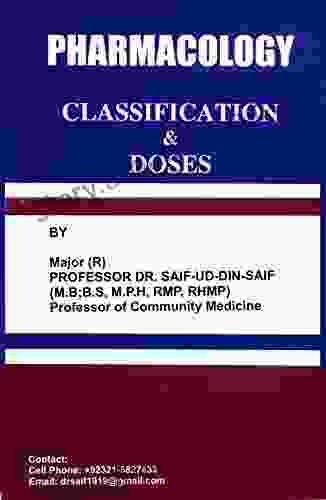Pharmacology Classification And Doses: The Ultimate Guide for Medical Professionals

****
Pharmacology is the study of the effects of drugs on living organisms. It is a complex and ever-changing field, with new drugs being developed all the time. In Free Download to understand pharmacology, it is important to be able to classify drugs and understand their different doses.
5 out of 5
| Language | : | English |
| File size | : | 5724 KB |
| Print length | : | 169 pages |
| Lending | : | Enabled |
This article provides a comprehensive guide to pharmacology classification and doses. It covers the different drug classes, their mechanisms of action, and their typical doses. It also discusses the factors that can affect drug dosing, such as the patient's age, weight, and medical condition. The guide is written in a clear and concise manner, making it an essential resource for medical professionals.
Drug Classification
Drugs can be classified into a number of different ways. One common method is to classify them based on their pharmacological effects. This method groups drugs into classes based on the way they affect the body. For example, drugs that affect the nervous system are classified as neuropharmacological agents.
Another common method of drug classification is to classify them based on their chemical structure. This method groups drugs into classes based on the way they are made. For example, drugs that contain the benzene ring are classified as aromatic drugs.
The following table provides a summary of the different drug classes and their typical uses:
| **Drug Class** | **Typical Uses** | |---|---| | **Analgesics** | Relieve pain | | **Anesthetics** | Produce loss of sensation | | **Antibiotics** | Kill or inhibit the growth of bacteria | | **Anticonvulsants** | Prevent or treat seizures | | **Antidepressants** | Treat depression | | **Antiemetics** | Prevent or treat nausea and vomiting | | **Antihistamines** | Block the effects of histamine | | **Antihypertensives** | Lower blood pressure | | **Antipsychotics** | Treat psychosis | | **Bronchodilators** | Open up the airways | | **Cardiac glycosides** | Strengthen the heart muscle | | **Chemotherapeutic agents** | Treat cancer | | **Corticosteroids** | Reduce inflammation | | **Diuretics** | Increase urine output | | **Hormones** | Regulate various body functions | | **Immunosuppressants** | Suppress the immune system |
Drug Doses
The dose of a drug is the amount of the drug that is given to a patient. The dose is determined by a number of factors, including the patient's age, weight, medical condition, and the drug's potency.
Drugs can be administered in a variety of ways, including orally, intravenously, intramuscularly, and subcutaneously. The route of administration affects the bioavailability of the drug, which is the amount of the drug that reaches the bloodstream.
The following table provides a summary of the different routes of administration and their typical bioavailability:
| **Route of Administration** | **Typical Bioavailability** | |---|---| | **Oral** | 50-80% | | **Intravenous** | 100% | | **Intramuscular** | 75-90% | | **Subcutaneous** | 50-75% |
The dose of a drug is typically expressed in milligrams (mg) or micrograms (mcg). The dose may be given as a single dose or as multiple doses over a period of time.
It is important to follow the dosing instructions provided by the healthcare professional. Taking too much of a drug can lead to overdose, which can be dangerous or even fatal.
Factors Affecting Drug Dosing
The dose of a drug can be affected by a number of factors, including:
**Age:** Children and elderly patients may require lower doses of drugs than adults.
**Weight:** Obese patients may require higher doses of drugs than patients who are not obese.
**Medical condition:** Patients with certain medical conditions may require adjusted doses of drugs. For example, patients with liver disease may require lower doses of drugs that are metabolized by the liver.
**Drug interactions:** Taking multiple drugs at the same time can affect the dose of each drug. For example, taking an antibiotic with a blood thinner can increase the risk of bleeding.
It is important to discuss all of the medications you are taking with your healthcare professional. This will help to ensure that you are taking the correct doses of your medications and that you are not at risk for drug interactions.
Pharmacology classification and doses are essential knowledge for medical professionals. This article has provided a comprehensive guide to the different drug classes and their typical doses. It has also discussed the factors that can affect drug dosing. By understanding pharmacology classification and doses, healthcare professionals can ensure that their patients are receiving the correct medication at the correct dose.
**Author:** Saif Ud Din Saif
5 out of 5
| Language | : | English |
| File size | : | 5724 KB |
| Print length | : | 169 pages |
| Lending | : | Enabled |
Do you want to contribute by writing guest posts on this blog?
Please contact us and send us a resume of previous articles that you have written.
 Book
Book Novel
Novel Page
Page Chapter
Chapter Text
Text Story
Story Genre
Genre Reader
Reader Library
Library Paperback
Paperback E-book
E-book Magazine
Magazine Newspaper
Newspaper Paragraph
Paragraph Sentence
Sentence Bookmark
Bookmark Shelf
Shelf Glossary
Glossary Bibliography
Bibliography Foreword
Foreword Preface
Preface Synopsis
Synopsis Annotation
Annotation Footnote
Footnote Manuscript
Manuscript Scroll
Scroll Codex
Codex Tome
Tome Bestseller
Bestseller Classics
Classics Library card
Library card Narrative
Narrative Biography
Biography Autobiography
Autobiography Memoir
Memoir Reference
Reference Encyclopedia
Encyclopedia Tiffany Lazic
Tiffany Lazic Kimberly Fowler
Kimberly Fowler Linsey Mcgoey
Linsey Mcgoey Liam Gildea
Liam Gildea Laura Town
Laura Town Lisa Messinger
Lisa Messinger Laurence Hull Stookey
Laurence Hull Stookey Vijender Sharma
Vijender Sharma Lynn R Kahle
Lynn R Kahle Max Serrano
Max Serrano Sam Jullius
Sam Jullius M G Sheftall
M G Sheftall Lynne Y Nakano
Lynne Y Nakano Tom Meyer
Tom Meyer P C Wren
P C Wren Lynn Eldridge
Lynn Eldridge Springhouse
Springhouse Mark Anderson
Mark Anderson M V Pipkin
M V Pipkin Leo M L Nollet
Leo M L Nollet
Light bulbAdvertise smarter! Our strategic ad space ensures maximum exposure. Reserve your spot today!

 E.E. Cummings24 Hours to Complete Bartholin Cyst Abscess Pain Relief - The Ultimate Guide
E.E. Cummings24 Hours to Complete Bartholin Cyst Abscess Pain Relief - The Ultimate Guide Brenton CoxFollow ·2.7k
Brenton CoxFollow ·2.7k Cruz SimmonsFollow ·9.7k
Cruz SimmonsFollow ·9.7k Ed CooperFollow ·10.9k
Ed CooperFollow ·10.9k Mark TwainFollow ·14.2k
Mark TwainFollow ·14.2k Vincent MitchellFollow ·16.8k
Vincent MitchellFollow ·16.8k Rod WardFollow ·14.5k
Rod WardFollow ·14.5k Tyrone PowellFollow ·6.3k
Tyrone PowellFollow ·6.3k Tennessee WilliamsFollow ·17.8k
Tennessee WilliamsFollow ·17.8k

 E.M. Forster
E.M. ForsterThe Real Blueprint to Short-Term Rental Success
Are you ready to create a...

 Mark Mitchell
Mark MitchellMidas Touch: The Astrology Of Wealth
Are you ready to tap into the cosmic forces...

 Grant Hayes
Grant HayesPrecarious Creativity: Unpacking the Global Media and...
In the ever-evolving landscape of the...

 Cameron Reed
Cameron ReedGuru Govind Singh: A Life of Courage and Inspiration for...
Guru Govind Singh, the tenth Sikh guru,...

 Yukio Mishima
Yukio MishimaCastles & Shapes: The Enchanting World of Ris...
In the realm of...

 Jerome Blair
Jerome BlairGolden Keys To Jyotisha Volume Ten: The Ultimate Guide to...
Embark on an...
5 out of 5
| Language | : | English |
| File size | : | 5724 KB |
| Print length | : | 169 pages |
| Lending | : | Enabled |










